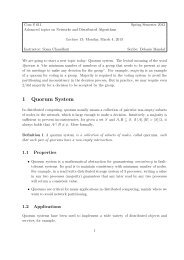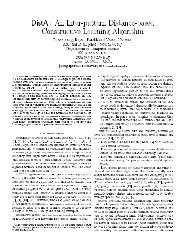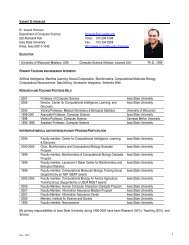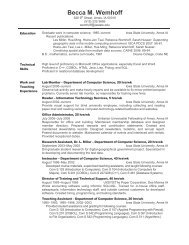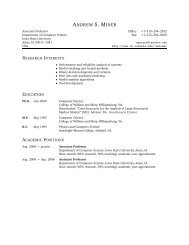Quaternions and Rotations∗ - Iowa State University
Quaternions and Rotations∗ - Iowa State University
Quaternions and Rotations∗ - Iowa State University
You also want an ePaper? Increase the reach of your titles
YUMPU automatically turns print PDFs into web optimized ePapers that Google loves.
We substitute the unit quaternion form (4) into (3) to obtain the resulting vector from rotating<br />
a vector v about the axis u through θ:<br />
(<br />
L p (v) = cos 2 θ 2 − θ )<br />
sin2 v + 2<br />
(usin θ )<br />
2 2 · v usin θ 2 + 2cos θ (usin θ )<br />
2 2 × v<br />
= cos θ · v + (1 − cos θ)(u · v)u + sinθ · (u × v). (6)<br />
Example 2. Consider a rotation about an axis defined by (1, 1, 1) through an angle of 2π/3. About this<br />
axis, the basis vectors i, j, <strong>and</strong> k generate the same cone when rotated through 2π. We define a unit vector<br />
u = 1 √<br />
3<br />
(1, 1, 1).<br />
Let the rotation angle θ = 2π/3. The quaternion q defines the rotation is then given as<br />
v = − 1 ⎝ 1 0 ⎠ +<br />
2<br />
0<br />
⎛<br />
− 1 ⎞ ⎛<br />
2<br />
= ⎝ 0 ⎠ ⎜<br />
+ ⎝<br />
0<br />
q = cos θ 2 + usin θ 2<br />
= 1 2 + 1 2 i + 1 2 j + 1 2 k.<br />
Let us compute the effect of rotation on the basis vector i = (1, 0, 0). We obtain the resulting vector<br />
using (6):<br />
⎛ ⎞<br />
⎛<br />
(<br />
1 + 1 )<br />
1 1<br />
· √ · √ ⎝ 1 ⎞ ⎛<br />
√<br />
1 ⎠ 3<br />
+<br />
2 3 3 2 · 1<br />
√ ⎝ 1 ⎞ ⎛<br />
1 ⎠ × ⎝ 1 ⎞<br />
0 ⎠<br />
1 3 1 0<br />
⎞ ⎛ ⎞<br />
= j.<br />
1<br />
2<br />
1<br />
2<br />
1<br />
2<br />
⎟ ⎜<br />
⎠ + ⎝<br />
0<br />
1<br />
2<br />
− 1 2<br />
⎟<br />
⎠<br />
The rotation of v under the operator L q can also be interpreted from the perspective of an<br />
observer attached to the vector v. What he sees happening is that the coordinate frame rotates<br />
through the angle −θ about the same axis defined by the quaternion.<br />
Theorem 2 For any unit quaternion<br />
q = q 0 + q = cos θ 2 + u sin θ 2 ,<br />
<strong>and</strong> for any vector v ∈ R 3 the action of the operator<br />
L q ∗(v) = q ∗ v(q ∗ ) ∗ = q ∗ vq<br />
is a rotation of the coordinate frame about the axis u through an angle θ while v is not rotated.<br />
Equivalently, the operator L q ∗ rotates the vector v with respect to the coordinate frame through<br />
an angle −θ about q.<br />
The quaternion operator L q (v) = qvq ∗ may be interpreted as a point or vector rotation with<br />
respect to the (fixed) coordinate frame. The quaternion operator L q ∗(v) = q ∗ vq may be interpreted<br />
as a coordinate frame rotation with respect to the (fixed) space of points.<br />
6



